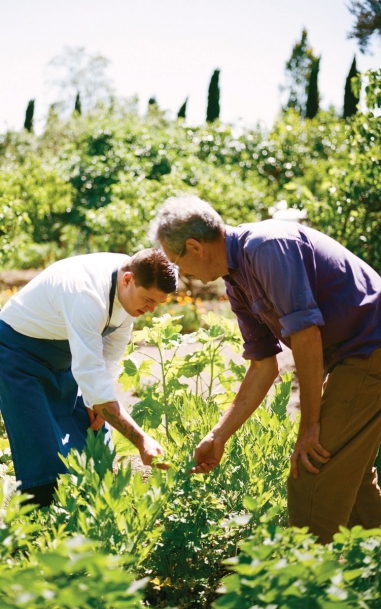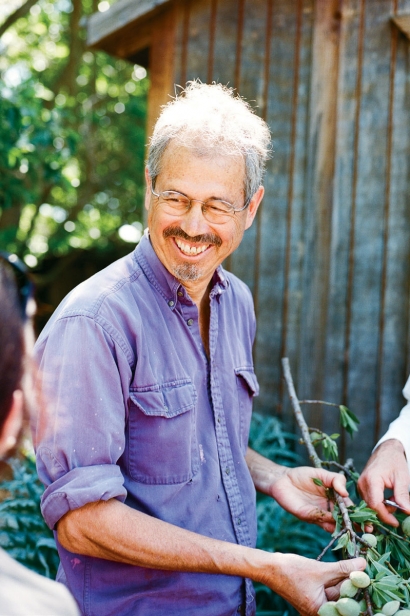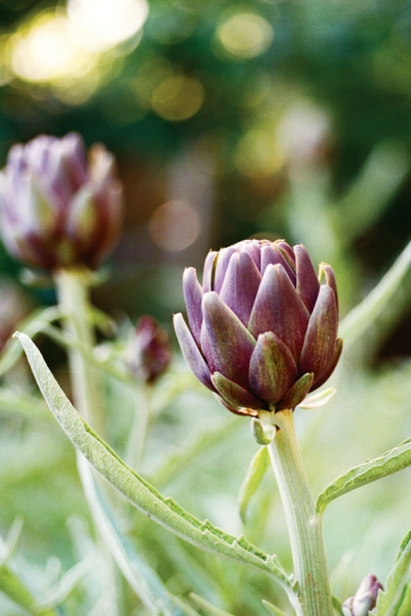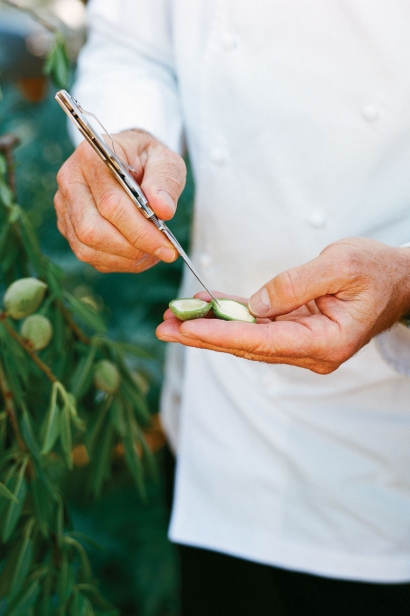Peter Jacobsen: The Chef's Farmer
It’s a timeworn writing cliché to describe a profile subject as complicated and unexpected, defying easy categorization. Sometimes it just means the writer isn’t trying hard enough.
But how else could you describe Peter Jacobsen, a man who’s a part-time practicing dentist, part-time working farmer? A man who has dined at some of the world’s most exclusive, high-concept eateries, yet prefers a simple farm meal at home? A man who lives half-time in the heart of bustling San Francisco, halftime in pastoral Yountville, liking them both in equal measure?
Please, excuse the cliché: Peter Jacobsen defies easy categorization.
The Journeyman Farmer
Let’s get this out of the way right off the bat—95% of Jacobsen’s produce goes to the French Laundry, a little restaurant you just might have heard of. That’s the big thing that people tend to focus on, but it’s only part of the story.
Jacobsen and his wife, Gwendolyn (Gwenny to those who know her), bought a house in Yountville 32 years ago, a retreat from hectic city life. It happened to have an acre and a third of land and 120 producing fruit trees, but that was incidental to the purchase.
At that point, Jacobsen was all dentist, without a lick of farming experience. According to him, his only qualification to work the land was “no fear of dirt.”
But hey, empires have been built on thinner résumés. Jacobsen didn’t know it at the time, but his agrarian education was only beginning.
The Jacobsens started opening their land to experienced farmers, people who could work the property with mastery. Not only would these farmers be able to wrangle amazing fruits and vegetables from the soil, they would pass on some of their hard-earned knowledge in the process.
Take, for instance, Tim Mueller and Trini Campbell. This dynamic duo worked the Jacobsen farm for a spell, as well as other nearby parcels of land. At some point, they asked Jacobsen if he wanted to be certified organic.
“I told them, ‘Sure, sounds good,’” he said. “They were young hippies and we were old hippies, so our philosophies lined up pretty well.”
The Jacobsen farm earned that organic certification, and Mueller and Campbell went on to found one of the most venerable organic farms in Northern California, Riverdog Farm in Guinda.
As the Jacobsens became more involved with tending their own land, they found their cup runneth over. Just one of their fig trees could produce 800–900 pounds of figs per season. There was no way two people could consume all the fruits of such a fertile parcel of land.
So they started trucking their wares to local restaurants, seeing what chefs could use. It’s reminiscent of the sepia-tinted stories of early Chez Panisse, when ragtag local farmers and home gardeners would approach the backdoor with a dozen perfect eggs, or a bundle of just-picked asparagus.
Jacobsen and his wife started forging partnerships with these local restaurants, including the one that would eventually put Yountville on the global culinary map, the French Laundry. A niche career was born.
Yes, Chef
Jacobsen learned early on that many chefs are yellers. They would yell at him that he came too late. They would yell at him that he came too early. They would yell at him that he didn’t have the right ingredients.
He didn’t take their ire personally, but he certainly didn’t love it. “When the head chef screams all the time, it trickles down,” he said. “Everyone yells at everyone. I’m not really into that.”
At the French Laundry, under the steady tutelage of Chef Thomas Keller, Jacobsen saw a different model at play. There, people set about their tasks with quietude, with purpose. Staffed with professionals of the highest magnitude, the French Laundry kitchen operated with the sleek efficiency of a Swiss engine.
This suited Jacobsen just fine. Not only would he be providing the raw materials to create top-shelf culinary masterworks—edible art for a rarified audience—but he would work with a chef who treated him with the respect that he deserved.
He initially worked out a system with the French Laundry wherein they would pay an annual fee to secure a bounty of his ingredients. This fee would not waiver, no matter what his production levels were.
This arrangement changed over the years, and Jacobsen now gets paid by the pound. But if you’re curious why arguably the country’s most prestigious restaurant would craft such a plum arrangement with a part-time dentist hobby farmer, perhaps you aren’t giving him enough credit.
Take, for instance, Jacobsen’s relationship with Chef Matthew Accarino at San Francisco’s Michelin-starred SPQR. Accarino, who worked under Keller at Per Se in New York, first met Jacobsen about a year ago. Since then, their relationship has evolved into what the chef calls “a valuable collaboration.”
Accarino drives up to Jacobsen’s farm about once a week, touring the property, seeing what’s new, checking the progress of various plants. But more valuable is the synergy between chef and farmer.
Accarino says Jacobsen opens his eyes to previously unimagined possibilities. This can be an item native to far-off regions, like Korean mint or Tokyo turnips. It can be a common item harvested at an unusual time, like the tiny unripe figs Accarino scored to make a bracing mostarda. Or it can be parts of a plant that often go overlooked, the vegetal equivalent of whole-beast butchery.
Take, for instance, the almond. Not exactly a choice piece of culinary esoterica. Yet Jacobsen recently introduced Accarino to the possibilities of using the entire almond in a dish. This can only be done at an early phase in the almond’s development, when the innards are still liquid and the outer pod isn’t too hard to chew. At Jacobsen’s urging, Accarino snapped up some of his whole almonds, with the goal to pickle and slice them, then serve them with suckling pig and rhubarb.
“Peter intuitively knew this was something that I’d be interested in, that I’d come alive with the possibilities,” said Accarino.
Alive With the Possibilities
Culinary farming doesn’t have an official definition, but Jacobsen thinks it should. He defines it as farmers who grow exclusively for restaurants, a new and ever-evolving concept.
Jacobsen teaches a class each year at the Culinary Institute of America at Greystone in St. Helena, titled “Chefs Training Farmers.” The goal is to show all the eager young pupils the value of a collaborative relationship, much like the one he shares with Keller. His theory is that most culinary farmers will never eat in the high-end restaurants they are growing for; most simply won’t be able to afford it. Thus, there is significant value in learning exactly where their ingredients will end up.
“The farmer won’t ever see the perfectly placed little piece of fennel being served on the plate, so they may not understand why it’s so important that it be a particular size,” Jacobsen says. “It’s the chef’s job to teach them.”
Yet in framing the chef as the one in charge, Jacobsen is selling his own contributions short. In many ways, he teaches chefs as much as they teach him.
True, he has actually eaten at the French Laundry (practicing dentistry is a nice supplement to the farming life), but that experience is not what sets him apart from other farmers. No, Jacobsen has an innate, almost chef-like sense of what possibilities lie dormant within produce, herbs and edible flowers.
As he guides you around his property, he’ll stop every few feet to pick an apple blossom off a tree, to pluck a piece of hyssop. As he gingerly samples each treasure, he encourages you to do the same, to taste what he tastes.
“He’s like a kid on a treasure hunt, or a mad scientist,” says David Breeden, the newly installed chef de cuisine at the French Laundry. “He’ll get this crazy look in his eyes when he’s biting down on a fennel bulb, when he’s smelling vegetables, when he’s smelling dirt.”
He’ll give you a bit of lovage, not telling you what it is. He’ll encourage you to “bruise” a bit between your teeth, careful not to let your palate drown in the flavor. Do you taste the celery notes? Do you think that would make a nice sorbet? If not, never fear. Jacobsen is there to lead you down the garden path (so to speak).
Jacobsen is not prone to fits of boasting, but he’ll readily own up to his keen palate. He’s something of a super-taster. This may not seem like a prerequisite for most farmers, but most farmers aren’t supplying the French Laundry and SPQR.
That’s how he can teach a master like Breeden, say, the benefits of a completely green orange. The insides may be inedible, but the zest has a potency of 10 ripe oranges, making it ideal for curing a nice filet of Japanese hirame.
“Peter is so good at illustrating what the potential of a plant can be,” Breeden says. “He’s really passionate about what he does, and he makes you see what a vegetable’s potential is.”
Quality Versus Quantity
With a reputation like Jacobsen’s, there is no shortage of demand for what he grows. The problem is a matter of scale.
For one thing, it’s just him, Gwenny and the occasional wandering farmhand who winds up on his property. (One of these wanderers was former French Laundry chef Scott Boggs, who has gone on to a successful career foraging for April Bloomfield and other top chefs in New York City.) There isn’t exactly a surplus of labor.
But perhaps more significantly, there is a matter of space. With only one and a third acres at his disposal, a space some would say skews closer to “garden” than “farm,” he simply cannot produce anything in high volume.
“I could never supply the volume they want,” says Jacobsen. “They need 100 little tiny lettuces every two days. I could do that maybe once every four weeks.”
This has the corollary effect of making his gardened goodies seem all the more valuable. For instance, he drives shipments down once a week to Accarino. Wednesdays and Thursdays become banner days for Jacobsen produce, with the knowledge that each shipment could run dry by the weekend.
Those fava leaves in Accarino’s riff on a Caesar salad? The nasturtium flowers topping his delicate carrot-on-carrot dish? The Hakurei turnips in his rich, sumptuous Wagyu beef and bonita entree? That’s right: get ’em while they last.
Accarino readily admits that he would love to get more of, say, Jacobsen’s lush violet artichokes. But scarcity adds to their value.
Of course, as with any finite resource, there is a bit of competition afoot. Norma Whitt, midway through the process of opening a new restaurant at St. Clair Brown Winery in St. Helena, is another chef jockeying with Accarino for resources with the French Laundry juggernaut.
Jacobsen says he tries to be thoughtful about distribution, for instance giving mustard rabe and rosemary flowers to Whitt—items that he doesn’t think the French Laundry would want.
It doesn’t always work out, though. Accarino said he “got real hot” on Mirabelle plums for a spell. But when he showed up one weekend to Jacobsen’s farm, all the Mirabelles were gone. Keller-owned “Bouchon Bakery had stripped the trees bare,” said Accarino. “They wanted the plums to use in tarts.”
But the incident was small, and easily forgotten. For the most part, harmony reigns on the Jacobsen farm.
A Yountville idyll
Considering Jacobsen’s dynamic, seemingly boundless energy, it’s amazing how peaceful his farm can seem. When he bought the property decades back, he didn’t really have neighbors. Now he is abutted on all sides by residential development.
But besides the occasional trill of a child’s laughter, or the low hum of a lawnmower, there is precious little to indicate how close the Jacobsen property is to the rest of society.Jacobsen actually enjoys the proximity. He never intended to plant himself “on the outer reaches of civilization,” so a farm tucked inside a town suits him just fine.
“I find it kind of cozy,” he said. “I love the sounds of a village, the children squawking and all that. It’s a medieval sort of thing.”
And for their part, he says the neighbors tolerate his tractor and his weed-control flamethrower. The tradeoff is, they get to look over and see the beautiful flowering trees throughout his property.
Perhaps they recognize their gift, of watching the sun go down on the Napa hills, listening to the crickets and the squawk of Jacobsen’s hens. It would probably be good enough for most of us.







